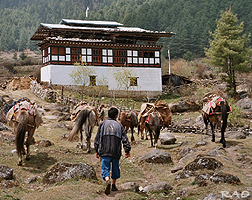 |
Bhutan's
Economy: Mules |
|
 |
Bhutan Information |
|
|
 |
 
|
Mules
in Bhutan: The benefits of breeding mules
|

|
Tashigang:
Mule Breeding Programme |
 |
The programme
began in 1998 as an off-farm activity to generate additional income for
farmers in the five geogs. The geogs were given a donkey each to start
breeding mules. "In the past mules were bred because they were a means
of transport and were best suited for pack pony," said Samten, a 52-year-old
farmer from Radhi and an expert in getting donkeys to mate with mares,
a skill he gained from his parents. "The mules have to be guided only once
through the path farmers normally travel and the next time they knew exactly
which path to take," he added.
A
Farmer in Phongmey |
 |
|
Mules
in Haa
Previously
only the required number of mules were bred to serve as pack ponies said
Tashi Tshering, 31, a farmer from Tokshimang village in Phongmey because
villages itself had very few horses needed to breed the mules. Gradually
farmers started buying more horses from Arunachal Pradesh and began
breeding more mules. "We sold one mule and bought five horses and used
them to produce more mules," said Tashi Tshering. "Now we have enough horses." |
|
|
Mule
breeding is costly |
 |
 |
According
to Tashi Tshering a good full grown horse might cost about Nu. 5,000 but
even a not fully developed mule fetches the at least Nu. 15,000. "A full
fledged mule with a desirable colour, can go upto about Nu. 30,000," he
said. Tashi Tshering said that buyers normally prefer a full-sized mule
with a reddish-brown colour, which indicates that they are supposedly stronger
and agile than other mules. Black tinted mules although fully developed
fetched only Nu. 12,000.
Tashi
Tshering sold three mules last year and used the income to renovate his
old home. He now runs a small general grocery shop. |
|
|
Mule
breeding and mating |
 |
According
to Tashi Tshering breeding mules is easy to manage, but if a male horse
mates with the same female horse that a donkey had mated with on the same
day, the female horse fails to produce offspring either of the horse or
the donkey.
 |
 |
During
the mule-breeding season from March to July, the donkey is made to mate
with about 15 mares in a day. |
 |
The
mares produce their offsprings, mules, in about 11 months. The mules have
to be fed and taken care of for about three more years till they gain their
full body weight and are fully grown. |
 |
Farmers
who bring their mares to mate with the donkey pay a fee of Nu. 10 and once
the mare produces a mule the farmer has to pay an additional Nu. 350 to
the owner of the donkey. |
|
|
|
Contributed
by Samten Wangchuk, Kuensel, Bhutan's national newspaper |
 |

|
|
Farms
in Haas
|

|










